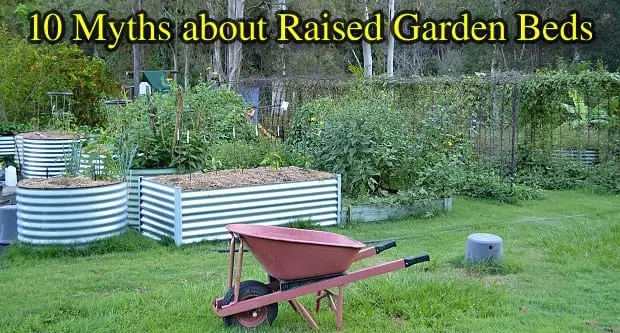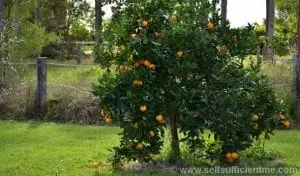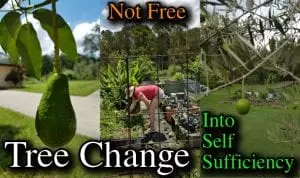Updated on 20th Sept 2022 If you have been reading Self Sufficient Me and watching some of my YouTube videos over the past several years, you’ll know how passionate I am about raised bed vegetable gardening.
There are many advantages raised bed food gardens have over the traditional in-ground garden beds that use the furrow method (like crop farmers do). The most obvious advantage is that raised bed gardening is more forgiving on the back when you’re working in the garden preparing beds, maintaining plants, or harvesting backyard crops.
Unfortunately, for whatever reason, there are several false myths circulating in the gardening community about raised beds. In this article, I’m keen to put to bed (like the pun…) some of the most popular myths about raised bed food gardening.
So, here are the top ten myths about raised bed gardening busted!

Myth 1 – The beds get overheated in hot climates
A large mound of dirt or a raised furrow doesn’t heat up much hotter than the surrounding ground soil, and the same is for a raised garden bed. The sheer mass of a raised garden bed makes it different to a 10-inch pot; therefore, a raised bed can’t be described as an oversized pot because there is simply no comparison. The depth of a raised garden bed means the soil below the surface remains cooler than the normal soil at ground level.
Not so long ago, a person who lives in Florida (USA) posted a message on my Instagram images about one of my raised garden beds, stating, “our plants would get cooked if we used such a bed in our subtropical climate here.” It made me think about writing this article to clear up this common misconception.
I just so happen to live in a subtropical climate, and the summers here can be unforgiving; however, I’ve never seen or experienced plants getting “cooked” in a raised bed due to the whole container heating up. Even raised beds made from steel, which could be expected to absorb heat more than wood, remain at a normal temperature.
I’m confident there’s little truth in the myth that raised bed gardens overheat.
Myth 2 – Raised beds take too much water
Last year, I visited a friend who lives on acreage, and they were in the process of getting into food gardening. I noticed they had prepared an area for a large vegetable garden, and I asked if they would make a series of raised beds. To my amusement, she said, “oh no, we’re not going build raised beds because they take too much water to maintain.” By the confidence in her statement, I could tell there was no way to convince her that raised garden beds are not evil water wasters, so I politely smiled.
Traditional in-ground furrows waste as much water (if not more) than raised beds because a lot of the water simply runs off down the pathways or gets evaporated. Whereas raised beds absorb water and contain runoff whilst preventing erosion, especially in areas with heavy rainfall.
The only time people get the impression that raised garden beds take too much water is when the medium (soil) they fill them with is too loose or sandy. Like an in-ground garden bed (or even a pot), the growing medium needs reasonably good water-holding qualities; otherwise, it will dry out too fast. If the raised garden bed is filled with good quality soil not too light or heavy, there won’t be any problem with the bed retaining water and being a good growing environment for plants.
Furthermore, if you are concerned about water holding in your raised bed, why not build a wicking area in the base of the bed?

This raised bed (image above) has asparagus and ginger surrounded by sweet potato vine
Myth 3 – Raised garden beds take too much soil to fill and therefore cost too much
When you first build a raised garden bed, it needs to be filled, which generally incurs an extra cost; however, it needn’t be as expensive as people tend to state.
The problem arises when all the soil is purchased in bags from the garden centre, and often this practice is encouraged by the retailer (for obvious reasons). I’ve even seen labelling on packaged raised beds in-store or online stating this bed takes 17 bags of “branded” garden soil etc… At $9 per bag, I admit filling a raised bed this way is expensive!
However, the best way to fill a raised garden bed is to purchase the soil in bulk either by visiting a landscaping centre with your trailer and purchasing a load of soil for between $40 – $60 depending on the quality you want; alternatively, get the soil delivered usually for a small fee.
The other mistake people often make is filling a high-sided raised bed from bottom to top with premium garden soil. Most vegetables and small fruiting crops only require 30-40cm (a foot) of topsoil to thrive. Therefore, filling a 2-foot-high raised bed full of good garden soil is a waste.
What I usually do is fill the bottom half of the bed with organic garden waste. Things like logs, sticks, pulled weeds, leaves, etc. and then on top of that, I throw my good garden soil. In the past, I have also used sand, crushed granite, or poor soil from down the back of my property as a “fill” for the bottom half of the bed, but lately, I have moved towards the softer organic matter, as mentioned above.
These organic materials create a living substructure in the base of the bed, attracting microbes, fungi, worms, and other animals, helping to make the overall bed healthier. Over time, the organic matter breaks down and turns into rich soil to be used by your hungry food crops.
This is particularly advantageous for places where the existing soil is poor because you can effectively create your soil in the raised beds and immediately grow crops all at the same time as growing your soil!
The image below shows the bottom half of the bed filled with organic waste then good soil is placed on top

Myth 4 – Raised beds have poor drainage
Yes, this is the opposite of myth 2, and even I fell for this one when I built my first high-sided raised beds. About 8-10 years ago, when I purchased our first colorbond steel 85cm high raised beds, the advice I received recommended I use drainage material (such as crushed granite) in the base of the bed to allow for good drainage. Over the years, I have realised this “drainage method” for raised beds is a complete myth!
The truth is, you could fill a raised bed with all the same good garden soil without any drainage and still have no problems. Most raised garden beds are simply mounds of dirt contained by a border keeping the soil from falling away. Because there’s no base, excess water will eventually drain through the bed naturally and effectively without needing a special drainage medium in the bottom.
An exception would be garden pods or raised beds with an enclosed base or wicking beds, but a standard raised bed situated above ground with an open base doesn’t technically require drainage.
Myth 5 – They don’t last very long
If people are worried about the longevity of a raised bed, they shouldn’t be… I’ve used wood, galvanised, colorbond steel, and poly, for several different types of raised beds on my property and all of these materials last a decade or twice that time (maybe longer). Yes, I have some pine sleeper beds that are looking a little ragged at the 10-year mark; however, I’m not going to replace the wood anytime soon because they’re still doing the job of holding the soil in place even though they don’t look the best.
In a testament to how long some of these beds last, as at the last editing of this article, I’ve had steel-raised beds last longer than 12 years with no rust!
For readers in the USA, I often get asked where these “steel” raised beds are because I can’t find them in the US, but let me assure you, they are slowly growing in popularity in America (see myth 10 below for places to buy them).
Overall, raised garden beds made from wood will probably last the shortest at around 10 – 15 years before they require replacement, and those made from galvanised/colorbond steel should last twice or three times longer.

Some of my galvanised raised beds (image above)
Myth 6 – Raised beds are too expensive to buy
I admit certain materials are more expensive than others when purchasing a raised bed. One of the most popular types of raised beds is colorbond steel, and several years ago, colorbond or galvanised beds were more costly than today. Thankfully, the rise in popularity and competition between sellers, plus perhaps the drop in steel prices, has reduced the average cost of a steel-raised garden bed considerably.
If you are willing to build your own raised bed, there are plenty of cost-effective materials you can use, such as; wood, wooden sleepers, old pallets, secondhand bricks, all sorts of recycled materials, etc. You can make the design simple or make the bed customised to suit your overall home or landscaping theme, depending on your budget. Concrete sleepers have been gaining popularity and are slightly more expensive than hardwood but last much longer, which should be considered when comparing prices.
Whatever you use for your raised bed, cheap or expensive, will eventually pay you back in food and convenience.
Myth 7 – Raised beds leach contaminants into the soil
There’s little evidence (if any) showing the negative effects of chemicals leaching into the soil from materials used in raised bed gardens. And, hypothetically, if chemicals did leach into the soil, I have not seen any evidence or study showing vegetable plants absorb these pollutants anyway. Plants are programmed to take up water, nutrients, minerals etc. And whilst a chemical in the soil may burn a root system, thus kill a plant, or prevent the take-up of nutrients, there’s doubt it would readily absorb bad chemicals showing nil effects and then pass these pollutants on to us when we eat it.
Colorbond and steel have been used in Australia to store drinking water for households and livestock for 100 years also, over the past few decades, poly tanks and garden beds have become popular. There’s no evidence (that I’m aware of) to the contrary other than these materials are safe to use for food plants.
I know there’s particular concern over the use of treated pine sleepers for raised garden beds, and I do understand how people can be apprehensive about using these products, particularly when building a raised garden bed to be used to grow food. For those concerned, I recommend using untreated hardwood or concrete sleepers for DIY-raised beds. I have used treated pine for raised garden beds before, and just to be on the safe side, I lined the wood inside with builder’s plastic. Also, I believe there is a new treatment for pine sleepers that has recently replaced the old treated timber, which is supposed to be food garden safe, so look for this product as well.
Concerning other types of raised beds, such as steel and poly (or plastic), I wouldn’t worry too much about it, to be honest… your soil is likely to have more contaminants than anything your raised garden bed may or may not leach out.

Some of the older beds (image above) were made with treated pine
Myth 8 – Raised beds are too hard to transport when I move house
In my mind, the fear of moving house is a poor excuse for not getting raised beds.
Just as raised beds can be easily built, they can also easily be taken down and moved. If the extra soil can’t be relocated for either practical or quarantine reasons, leave it at the old residence and spread the soil out around the existing garden.
Too often, people make excuses preventing them from living a healthier lifestyle, such as growing fruit & veg. The fact that we might move house one day is simply not a justifiable excuse for not building a raised bed garden or two.
Myth 9 – Raised beds are too hard to build
I’ve touched on this point already throughout this article, and I can confidently say if I can build a raised garden bed, then anyone can! I’m not the most gifted handyman, but these days flat, packed garden beds are dead easy to assemble, and some take just a few minutes!
You can also buy raised garden beds already assembled, get them delivered, or use your trailer to transport them.
If you decide to build your own raised beds, many ways and construction products make joining wood or setting bricks so easy it’s simply stacked, filled with dirt and plants, and enjoy! So, don’t be daunted by the prospect of building your raised garden bed.

Here’s a simple raised garden bed being built (Image courtesy of our forum member Ash)
Myth 10 – Raised beds are too hard to find
I guess I have exaggerated this last myth because although I do get the odd, “where did you get that bed from?” I don’t hear it very often, but it allows me to wrap up this article with a plug about the best place to get the best-raised beds I recommend and use personally:
If you are in the USA, UK, or Canada, check out my mate Kevin – from Epic Gardening here and use SSME2020 on checkout for 5% off.
In Australia, go to Birdies Garden Products Australia and use code SSMEbird for a 5% discount, or in New Zealand, go to Birdies Garden Products NZ and use Code ssmebird22 for 5% off your first purchase.
Conclusion
Well, there are ten myths about raised garden beds busted! If you are considering building some raised beds for your vegetable garden, I hope the information in this article has helped or inspired you.
Remember to: Look, and see the Earth through her eyes… Or, If you can’t be self-sufficient in everything, be self-sufficient in something…













